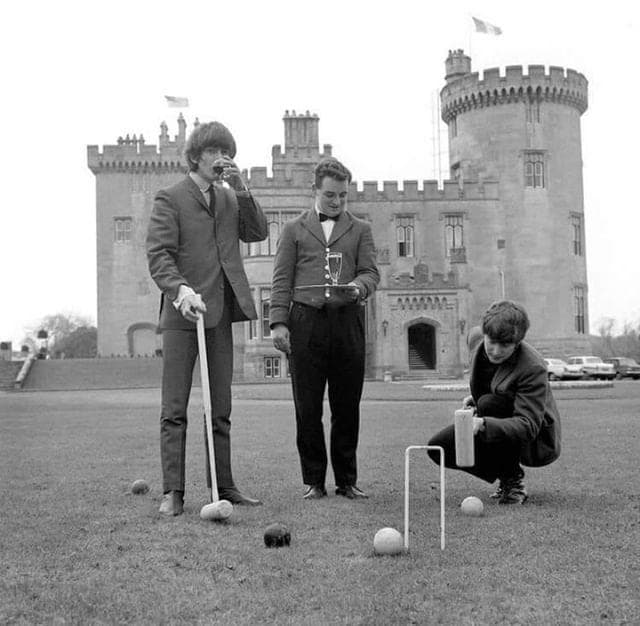
Hard to believe John Lennon would have been 80 today. This is a photo of John & George in Dromoland Castle, Co Clare, 1964. John’s days at the Cliffs of Moher and Dromoland Castle in the 1960’s were an escape during the heights of Beatlemania. He felt an inexplicable bond with Ireland, a bond born in the blood. John & Yoko bought Dorinish Island off the coast of Co. Mayo in 1967. Lennon revealedto friends his plan to build a home and retire there. In a 1971 interview, John stated: “I told Yoko that’s where we’re going to retire, and I took her to Ireland. We went around Ireland a bit and we had a sort of second honeymoon there. So I was completely involved in Ireland.” Yoko Ono attested to John's love for Ireland in an interview in 2012. "My husband was 100% Irish. That's what he used to say. Ireland was sort of like an auntie or a mother that he wanted to show me". “When he was born, his mother was English and his father was Irish and he didn’t have too much opportunity to see his father, so he had this yearning for being Irish. In a way it was sad because he was always talking about that" Lennon's grandfather, John (Jack) Lennon was born in Dublin in 1858, and like so many Irish people emigrated to Liverpool to seek better prospects of employment. There Jack married an Irishwoman called Mary Maguire and started a family. Sadly, their children, including Alfred (Johns Father), were orphaned early on and grew up in Liverpool orphanages. The Irish side of Johns family came from a long line of minstrel singers and crooners. His grandfather Jack had earned his living as a minstrel singer, and his great-grandfather was also a known singer in Ireland. His father Alfred Lennon had also earned extra money singing as a young man. The Lennon family tradition of crooning, continued with John Lennon. As biographer Jon Wiener aptly stated in ‘Come Together: John Lennon in His Time’, John “thought of himself as Irish.” His 1972 solo LP, Some Time In New York City, stepped out courageously in protest of Northern Ireland and British internment of Irish without trial (a practice begun on 9th August 1971), offering two songs – “Sunday Bloody Sunday” and “The Luck of the Irish” - as Lennon’s undiluted anthems for Irish rights. In “Luck of the Irish". Lennon held nothing back in his anger and resentment. All royalties from both “Sunday Bloody Sunday” and “Luck of the Irish” were donated by John and Yoko to Irish civil rights organisations in both New York and Ireland. As the years passed, his passion for Ireland only increased. On 5 February 1972, John took to the streets of New York with Jerry Rubin and 5,000 supporters protesting outside the offices of British owned airlines 'BOAC'. In protest of Britain’s practices in Ireland, John wanted to stand tall and be counted in the cause. And that Irish ardor only increased. John’s use of the term “our marches” in interviews shows his “all-in” involvement with the Irish movement at the time. Risking his reputation by speaking out (and singing loud) for Ireland, (both “Sunday Bloody Sunday” and “Luck of the Irish” were banned by the BBC and John’s latter appearances were picketed by Loyalist groups), John Lennon stood his ground for Ireland, the verdant land from which his family sprang. Whether you spell his surname Ó Lionain, Ó Leannian, or Lennon, the name still comes from the Gaelic term 'leannan' meaning “lover or paramour.” And nothing could be more appropriate. John loved Ireland with a passion that only amplified as he matured and aged. By 1974, when John’s Walls and Bridges LP was released, he included a booklet containing a detailed history of the Lennon family originally printed in ‘Irish Families, Their Names, Arms, and Origins’ by Edward MacLysaght. Interestingly, at the end of that entry where MacLysaght had written, “No person of the name of Lennon has distinguished himself in the political, military, or cultural life of Ireland…” John angrily scribbled in the margin, “Oh yeh? John Lennon!” And as usual, John was right. In fact, MacLysaght’s 1982 revised edition of Irish Families carried this amendment: “Since the 4th edition of Irish Families, John Lennon, an outstanding member of The Beatles group, assassinated in 1980, has become well known outside Ireland not only as a talented musician but also for his connection with the Peace Movement.” And with this notation, the Lennon family assumed its rightful place in Irish history. His devotion to the land of his fathers and grandfathers was undiminished at the time of his assassination. He named his second son Seán, the Gaelic version of his own name. About a year before he was shot his London solicitor began organising planning permission for Dorinish Island off the coast of Co. Mayo. Following his murder, Yoko Ono sold the island to local farmers in 1984. She donated the £30,000 proceeds to an Irish children’s charity. So imagine John Lennon at 80 living on an island off the Mayo coast. It could have happened!



